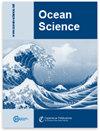Unsupervised classification of the northwestern European seas based on satellite altimetry data
IF 4.1
3区 地球科学
Q2 METEOROLOGY & ATMOSPHERIC SCIENCES
引用次数: 0
Abstract
Abstract. From generating metrics representative of a wide region to saving costs by reducing the density of an observational network, the reasons to split the ocean into distinct regions are many. Traditionally, this has been done somewhat arbitrarily using the bathymetry and potentially some artificial latitude–longitude boundaries. We use an ensemble of Gaussian mixture models (GMMs, unsupervised classification) to separate the complex northwestern European coastal region into classes based on sea level variability observed by satellite altimetry. To reduce the dimensionality of the data, we perform a principal component analysis on 27 years of observations and use the spatial components as input for the GMM. The number of classes or mixture components is determined by locating the maximum of the silhouette score and by testing several models. We use an ensemble approach to increase the robustness of the classification and to allow the separation into more regions than a single GMM can achieve. We also vary the number of empirical orthogonal function (EOF) maps and show that more EOFs result in a more detailed classification. With three EOFs, the area is classified into four distinct regions delimited mainly by bathymetry. Adding more EOFs results in further subdivisions that resemble oceanic fronts. To achieve a more detailed separation, we use a model focused on smaller regions, specifically the Baltic Sea, North Sea, and the Norwegian Sea.根据卫星测高数据对欧洲西北部海域进行无监督分类
摘要从生成代表广泛区域的指标到通过降低观测网络的密度来节约成本,将海洋划分为不同区域的理由有很多。传统的做法是利用水深测量和一些人为的纬度-经度边界来随意划分区域。我们根据卫星测高观测到的海平面变化,使用高斯混合模型(GMMs,无监督分类)将复杂的欧洲西北部沿海地区分成不同的类别。为了降低数据的维度,我们对 27 年的观测数据进行了主成分分析,并将空间成分作为 GMM 的输入。通过定位剪影得分的最大值和测试多个模型来确定类别或混合成分的数量。我们使用集合方法来提高分类的稳健性,并允许比单个 GMM 所能实现的更多区域的分离。我们还改变了经验正交函数(EOF)图的数量,结果表明,EOF 越多,分类就越详细。在使用三个 EOF 的情况下,该区域被划分为四个主要由水深划定的不同区域。增加更多的 EOFs 可进一步细分为类似海洋前沿的区域。为了实现更详细的划分,我们使用了一个侧重于较小区域的模型,特别是波罗的海、北海和挪威海。
本文章由计算机程序翻译,如有差异,请以英文原文为准。
求助全文
约1分钟内获得全文
求助全文
来源期刊

Ocean Science
地学-海洋学
CiteScore
5.90
自引率
6.20%
发文量
78
审稿时长
6-12 weeks
期刊介绍:
Ocean Science (OS) is a not-for-profit international open-access scientific journal dedicated to the publication and discussion of research articles, short communications, and review papers on all aspects of ocean science: experimental, theoretical, and laboratory. The primary objective is to publish a very high-quality scientific journal with free Internet-based access for researchers and other interested people throughout the world.
Electronic submission of articles is used to keep publication costs to a minimum. The costs will be covered by a moderate per-page charge paid by the authors. The peer-review process also makes use of the Internet. It includes an 8-week online discussion period with the original submitted manuscript and all comments. If accepted, the final revised paper will be published online.
Ocean Science covers the following fields: ocean physics (i.e. ocean structure, circulation, tides, and internal waves); ocean chemistry; biological oceanography; air–sea interactions; ocean models – physical, chemical, biological, and biochemical; coastal and shelf edge processes; paleooceanography.
 求助内容:
求助内容: 应助结果提醒方式:
应助结果提醒方式:


